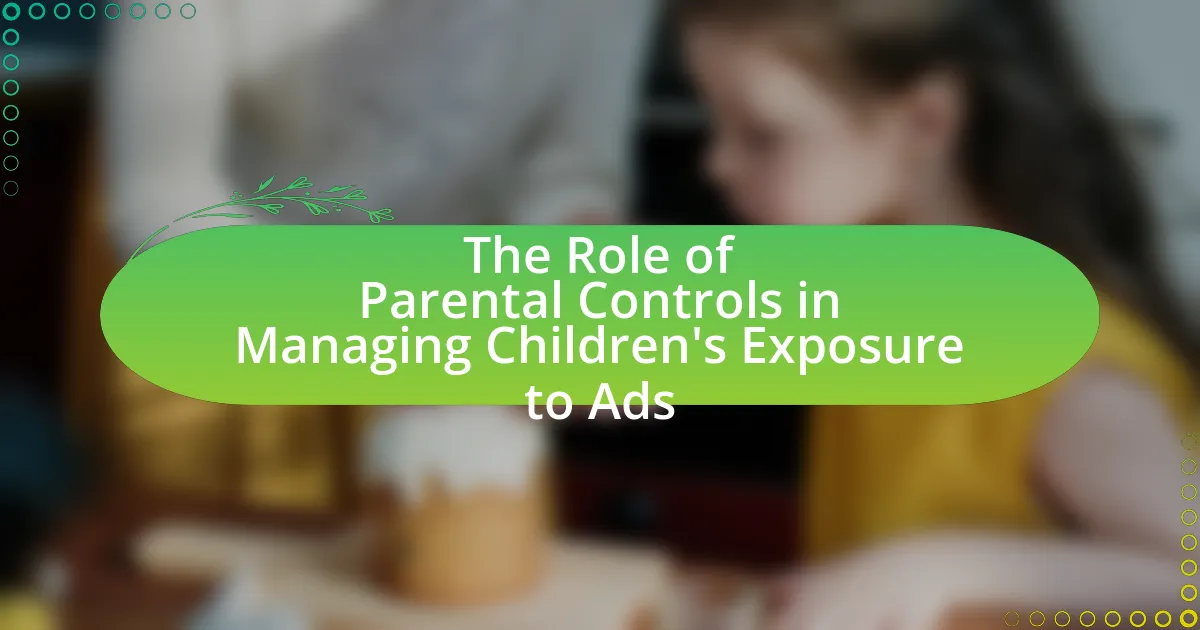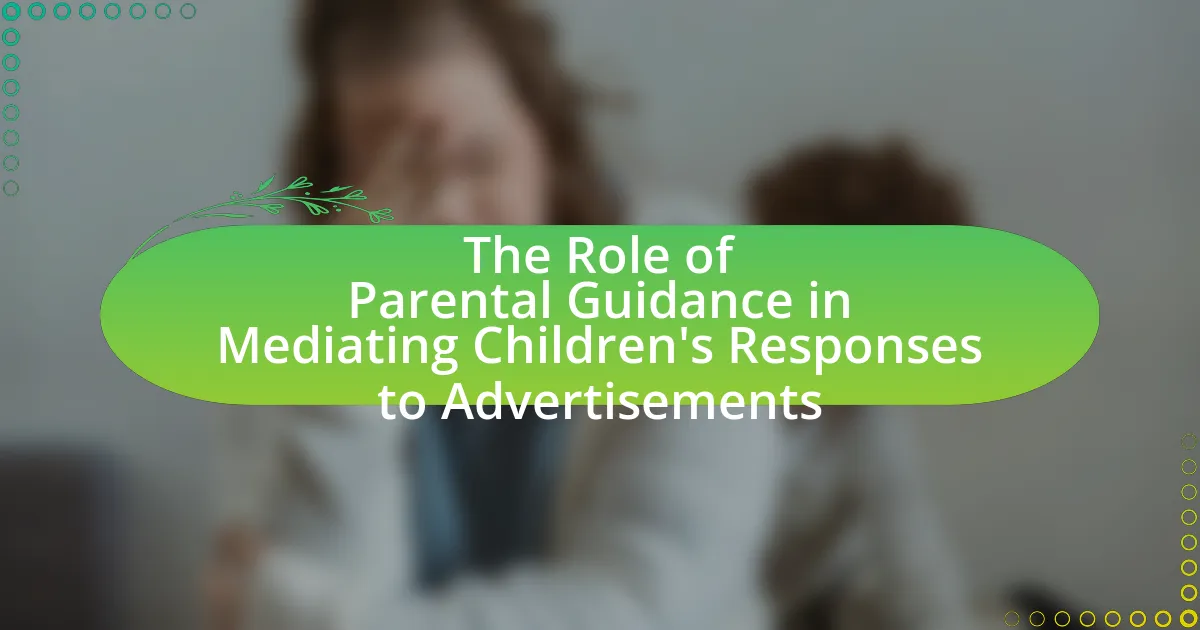The article focuses on how parents can foster critical thinking in children regarding advertisements. It outlines the significant role advertisements play in shaping children’s preferences and behaviors, emphasizing the need for parental guidance to help children understand persuasive techniques used in ads. Key topics include the differences in perception between children and adults, common types of advertisements targeting children, and the importance of critical thinking in decision-making. The article also provides practical strategies for parents to engage their children in discussions about ads, address misconceptions, and utilize resources to enhance media literacy.

How can parents help children understand advertisements?
Parents can help children understand advertisements by engaging them in discussions about the intent and techniques used in ads. By explaining how advertisements are designed to persuade and influence consumer behavior, parents can foster critical thinking skills. For instance, parents can point out specific strategies such as emotional appeals, celebrity endorsements, and exaggerated claims, which are commonly used in advertising. Research indicates that children as young as 8 years old can begin to recognize these persuasive techniques when guided by adults. This understanding helps children become more discerning consumers, enabling them to question the messages they encounter in media.
What role do advertisements play in children’s lives?
Advertisements play a significant role in children’s lives by influencing their preferences, behaviors, and purchasing decisions. Research indicates that children are exposed to thousands of advertisements each year, which can shape their understanding of products and brands. For instance, a study published in the journal “Pediatrics” found that children aged 2 to 11 view an average of 25 hours of television per week, leading to increased brand recognition and preference for advertised products. This exposure can lead to materialistic attitudes and impact their social interactions and self-esteem. Therefore, advertisements not only inform children about products but also play a crucial role in shaping their values and consumer habits.
How do children perceive advertisements differently than adults?
Children perceive advertisements differently than adults primarily due to their cognitive development and understanding of persuasive intent. While adults can critically analyze the motives behind advertisements, children often take the messages at face value, believing them to be truthful and straightforward. Research indicates that children under the age of eight typically lack the ability to recognize the persuasive nature of advertising, leading them to be more susceptible to its influence. For instance, a study published in the Journal of Consumer Research by John A. Bargh and others found that children are more likely to be swayed by emotional appeals in ads, as they have not yet developed the critical thinking skills necessary to question the content. This difference in perception highlights the importance of parental guidance in helping children develop a more analytical approach to advertisements.
What types of advertisements are most common for children?
The most common types of advertisements for children include animated commercials, toy advertisements, and food product promotions. Animated commercials often utilize colorful graphics and characters to capture children’s attention, making them highly effective in engaging young audiences. Toy advertisements frequently showcase popular brands and new releases, appealing to children’s desires for play and imagination. Food product promotions, particularly those for sugary cereals and snacks, are prevalent and often feature mascots or fun themes to attract children’s interest. Research indicates that children are particularly susceptible to these types of advertisements, as they may not fully understand the persuasive intent behind them, leading to increased demand for advertised products.
Why is critical thinking important when it comes to ads?
Critical thinking is important when it comes to ads because it enables individuals to analyze and evaluate the messages being presented, leading to informed decision-making. By applying critical thinking skills, consumers can discern the persuasive techniques used in advertisements, such as emotional appeals or misleading claims, which often aim to manipulate perceptions and behaviors. Research indicates that children exposed to critical thinking exercises are better equipped to recognize advertising strategies, reducing susceptibility to deceptive marketing practices. For instance, a study published in the Journal of Consumer Research found that children who engaged in critical thinking activities demonstrated a greater ability to identify biased information in ads, highlighting the necessity of fostering these skills in young audiences.
How does critical thinking influence children’s decision-making?
Critical thinking significantly enhances children’s decision-making by enabling them to analyze information, evaluate options, and consider consequences before acting. This cognitive skill allows children to discern between persuasive advertising and factual content, leading to more informed choices. Research indicates that children who engage in critical thinking are better equipped to resist manipulative marketing tactics, as they can question the motives behind advertisements and assess the credibility of claims. For instance, a study published in the Journal of Consumer Research by authors such as McAlister and Cornwell demonstrates that children trained in critical thinking are less likely to be swayed by misleading advertisements, showcasing the direct impact of critical thinking on their decision-making processes.
What are the potential consequences of uncritical acceptance of ads?
Uncritical acceptance of ads can lead to misinformation and manipulation of consumer behavior. When individuals do not critically evaluate advertisements, they may be misled by exaggerated claims or deceptive marketing tactics, resulting in poor purchasing decisions. Research indicates that children, who are particularly susceptible to advertising, may develop unrealistic expectations about products, leading to dissatisfaction and materialism. For instance, a study by the American Psychological Association found that exposure to advertising can influence children’s preferences and consumption patterns, often prioritizing brand recognition over quality. This uncritical acceptance can also perpetuate harmful stereotypes and societal norms, as ads often reflect and reinforce existing biases.
What strategies can parents use to foster critical thinking about ads?
Parents can foster critical thinking about ads by encouraging children to analyze the content and intent of advertisements. This can be achieved through discussions that prompt children to question the message, target audience, and persuasive techniques used in ads. For instance, parents can ask questions like, “What is this ad trying to sell?” or “Who do you think this ad is aimed at?” Research indicates that engaging children in such dialogues enhances their ability to critically evaluate media messages, as demonstrated in studies by the American Psychological Association, which highlight the importance of media literacy in developing critical thinking skills.
How can discussions about ads be initiated at home?
Discussions about ads can be initiated at home by encouraging children to share their thoughts on advertisements they encounter in daily life. Parents can ask open-ended questions about specific ads, such as what the child thinks the ad is trying to sell and whether they find it persuasive. This method fosters critical thinking by prompting children to analyze the intent and effectiveness of the advertisement. Research indicates that engaging children in conversations about media can enhance their understanding of marketing strategies and develop their analytical skills, making them more discerning consumers.
What questions should parents ask their children about ads?
Parents should ask their children questions such as: “What product is being advertised?” and “What message do you think the ad is trying to convey?” These questions encourage children to identify the product and analyze the intent behind the advertisement. Additionally, parents can ask, “Who do you think the target audience is?” to help children understand marketing strategies. Another important question is, “Do you think the ad is truthful?” which prompts critical evaluation of the claims made in the advertisement. Lastly, asking, “How does this ad make you feel?” allows children to reflect on emotional responses to advertising. These inquiries foster critical thinking by engaging children in discussions about advertising techniques and their implications.

What are the challenges parents face in teaching critical thinking about ads?
Parents face several challenges in teaching critical thinking about ads, primarily due to the pervasive nature of advertising and the sophistication of marketing techniques. The constant exposure to advertisements across various media makes it difficult for parents to engage children in meaningful discussions about the intent and impact of these ads. Additionally, many advertisements employ persuasive tactics that can easily mislead children, who may lack the cognitive skills to critically analyze the content. Research indicates that children under the age of eight are particularly susceptible to advertising messages, as they often cannot distinguish between entertainment and marketing, complicating parents’ efforts to instill critical thinking. Furthermore, parents may struggle with their own understanding of advertising strategies, which can hinder their ability to effectively teach their children how to question and evaluate ads critically.
How do children’s developmental stages affect their understanding of ads?
Children’s developmental stages significantly influence their understanding of advertisements. Younger children, typically under the age of 7, often lack the cognitive skills to critically analyze ads, viewing them as literal truths rather than persuasive messages. As children grow, particularly between ages 7 and 12, they begin to develop critical thinking skills and can recognize persuasive intent, but they may still struggle with distinguishing between entertainment and advertising. Research indicates that by age 12, children are more adept at understanding the techniques used in advertising, such as emotional appeals and celebrity endorsements, allowing them to question the validity of the messages presented. This progression highlights the importance of parental guidance in fostering critical thinking skills to help children navigate advertising effectively.
What misconceptions do children have about advertisements?
Children often believe that advertisements are entirely truthful and represent reality, leading them to think that the products shown will deliver the same results as depicted. This misconception arises because children may not yet have the cognitive ability to critically analyze persuasive messages or understand the intent behind advertising. Research indicates that children under the age of eight are particularly susceptible to these misleading representations, as they struggle to differentiate between entertainment and marketing. For instance, a study published in the Journal of Consumer Research found that children are more likely to accept claims made in advertisements without skepticism, which can lead to unrealistic expectations about products.
How can parents address these misconceptions effectively?
Parents can address misconceptions about advertisements effectively by engaging in open discussions with their children about the intent and techniques used in advertising. By explaining how ads often exaggerate benefits or create unrealistic expectations, parents can help children develop a critical perspective. Research indicates that children as young as 8 years old can understand persuasive intent when it is explicitly discussed, which reinforces the importance of parental involvement in media literacy. Additionally, parents can encourage children to analyze specific ads together, asking questions about the message, target audience, and emotional appeal, thereby fostering critical thinking skills.
What external factors influence children’s perceptions of advertisements?
External factors that influence children’s perceptions of advertisements include parental guidance, peer influence, media exposure, and cultural context. Parental guidance shapes children’s understanding of advertisements through discussions about marketing tactics and critical evaluation of content. Peer influence can lead children to adopt similar attitudes towards advertisements based on their friends’ opinions and behaviors. Media exposure, including the frequency and type of advertisements children encounter, significantly affects their perceptions, as studies show that children exposed to more ads tend to have a more favorable view of advertised products. Cultural context also plays a role, as societal norms and values can shape how children interpret and respond to advertising messages.
How do peer influences affect children’s views on ads?
Peer influences significantly shape children’s views on advertisements by affecting their perceptions of brand value and product desirability. When children observe their peers expressing enthusiasm or approval for certain ads, they are more likely to adopt similar positive attitudes towards those products. Research indicates that children aged 8 to 12 are particularly susceptible to peer opinions, as they often seek social acceptance and validation from their friends. A study published in the Journal of Advertising Research found that children are more likely to trust and engage with advertisements that their peers endorse, highlighting the powerful role of social dynamics in shaping consumer behavior.
What role does media literacy play in understanding advertisements?
Media literacy plays a crucial role in understanding advertisements by equipping individuals with the skills to critically analyze and evaluate media messages. This understanding enables consumers to discern persuasive techniques, identify biases, and recognize the intent behind advertisements. Research indicates that individuals with higher media literacy are better at detecting misleading information and understanding the emotional appeals used in advertising, which can lead to more informed decision-making. For instance, a study by the National Association for Media Literacy Education highlights that media literacy education significantly improves students’ ability to critically assess advertisements, fostering a more discerning audience.

How can parents reinforce critical thinking skills in everyday situations?
Parents can reinforce critical thinking skills in everyday situations by engaging children in discussions that require them to analyze information and make reasoned judgments. For example, when watching advertisements, parents can ask questions like, “What do you think the purpose of this ad is?” or “How does this product compare to others?” This approach encourages children to evaluate the credibility of the information presented and consider different perspectives. Research indicates that children who are regularly prompted to think critically about media content develop stronger analytical skills, which are essential for navigating a complex information landscape.
What everyday activities can promote critical thinking about ads?
Engaging in discussions about advertisements during family activities can promote critical thinking about ads. For instance, while watching television or browsing online, parents can ask children questions about the ads they see, such as the target audience, persuasive techniques used, and the product’s actual benefits. This interactive dialogue encourages children to analyze and evaluate the messages conveyed in advertisements. Research indicates that children who participate in discussions about media content develop better critical thinking skills, as they learn to question and assess the information presented to them.
How can shopping trips be used as learning opportunities?
Shopping trips can be used as learning opportunities by engaging children in discussions about budgeting, product choices, and advertising strategies. During these trips, parents can teach children how to compare prices, evaluate product quality, and understand the influence of advertisements on their purchasing decisions. For instance, a study by the American Psychological Association highlights that children exposed to discussions about marketing tactics develop better critical thinking skills regarding ads. This practical experience reinforces theoretical knowledge, making shopping a valuable educational tool.
What role do family discussions about media play in critical thinking development?
Family discussions about media significantly enhance critical thinking development in children. Engaging in conversations about media content allows children to analyze, evaluate, and question the information presented to them. Research indicates that when parents discuss advertisements and media messages with their children, it encourages children to think critically about the intent and credibility of the information, fostering skills such as skepticism and discernment. For instance, a study published in the Journal of Advertising Research found that children who participated in family discussions about media were better equipped to identify persuasive techniques used in advertisements, demonstrating a clear link between these discussions and improved critical thinking abilities.
What resources are available for parents to support critical thinking about ads?
Parents can access various resources to support critical thinking about advertisements, including educational websites, books, and workshops. Websites like Common Sense Media provide reviews and guides on media literacy, helping parents teach children to analyze ads critically. Books such as “Media Literacy: Keys to Interpreting Media Messages” by W. James Potter offer insights into understanding media content. Additionally, local community centers or schools often host workshops focused on media literacy, equipping parents with tools to engage their children in discussions about advertising techniques and persuasive strategies. These resources collectively empower parents to foster critical thinking skills in their children regarding ads.
What books or materials can help parents teach their children about ads?
Books and materials that can help parents teach their children about ads include “The Advertising Effect: How to Change Behaviour” by Adam Ferrier, which explains the psychology behind advertising and how to critically analyze ads. Additionally, “Kid’s Guide to Advertising” by the American Psychological Association provides insights into how ads are designed and their impact on children. The resource “Media Literacy: A Parent’s Guide” from the National Association for Media Literacy Education offers practical strategies for discussing media and advertising with children. These materials are effective because they provide concrete examples and frameworks for understanding advertising’s influence, fostering critical thinking skills in young audiences.
How can online resources and tools assist in fostering critical thinking?
Online resources and tools can significantly assist in fostering critical thinking by providing access to diverse information, interactive learning experiences, and analytical frameworks. These resources, such as educational websites, online courses, and critical thinking games, encourage children to evaluate advertisements critically by analyzing content, identifying biases, and questioning the intent behind marketing messages. For instance, platforms like Common Sense Media offer reviews and discussions on media literacy, helping children discern the credibility of ads. Additionally, tools like Google Scholar enable access to research articles that discuss advertising strategies and their psychological impacts, further enhancing analytical skills. Studies show that engaging with varied online content can improve critical thinking abilities, as children learn to synthesize information and form reasoned judgments.
What are some practical tips for parents to encourage critical thinking regarding ads?
Parents can encourage critical thinking regarding ads by engaging children in discussions about the content and intent of advertisements. For instance, parents can ask questions like, “What do you think this ad is trying to sell?” or “How does this ad make you feel?” This approach helps children analyze the persuasive techniques used in ads, such as emotional appeals or celebrity endorsements. Additionally, parents can encourage children to compare similar products and their advertisements, fostering an understanding of marketing strategies and consumer choices. Research indicates that children who actively discuss and critique advertisements develop better analytical skills and are less susceptible to manipulation by marketing tactics.






